Traditional feed additive copper sulfate has the disadvantages of caking due to moisture absorption, strong oxidability, damage to processing equipment and accelerated failure of nutrients, enzymes, vitamins and fat in feed, resulting in decreased palatability of feed. SUSTAR tri-basic copper chloride product features low hygroscopicity, good flowability, structural stability, weak oxidability and high bioavailability and is hailed as a “revolutionary” copper source.
Product Information
Chemical name: Tri-basic copper chloride
Molecular formula: Cu₂(OH)₃Cl
Molecular weight: 213.57
Character: Dark green or pale green powder, non-caking, with good physical and chemical flowability.
Physical and Chemical Indicators
|
Ingredients |
Index |
|
|
Cu₂ (OH)₃Cl,% |
≥97.8 |
|
|
Copper content, % |
≥58 |
|
|
Arsenic (subject to As), mg/kg |
≤10 |
|
|
Plumbum (subject to Pb), mg/kg |
≤10 |
|
|
Cadmium (subject to Cd), mg/kg |
≤3 |
|
|
Mercury (subject to Hg), mg/kg |
≤0.1 |
|
|
Moisture, % |
≤0.5 |
|
|
Fineness (through W=250μm test sieve), % |
≥95 |
|
|
Note: Dioxin and PCB contained in the product conform to EU standard |
||
Product Features
l Low hygroscopicity and not prone to deliquescence.
The product can effectively prevent caking arising from moisture absorption of tri-basic copper chloride and extend the storage life.
l Good uniformity
With grain diameter of 0.05-0.15mm and good flowability, it can avoid copper poisoning for not mixing with feed evenly.
l Effectively reduce nutrient loss of feed
Cu2+ is linked by covalent bond to improve structural stability and weaken the oxidation of vitamins, phytase and fat in feed.
l High biological value
With higher bioavailability, tri-basic copper chloride can reduce the dosage and promote growth.
l Good palatability
Palatability determines the absorption level of feed. Tri-basic copper chloride has good palatability since its pH value is approximate to a neutral value.
Application
(I) Weaned piglets
Adding appropriate tri-basic copper chloride into daily ration of weaned piglet can improve the antioxidant enzyme activities of CER and Cu/Zn-SOD in serum of weaned piglet and reduce oxidative stress response and diarrhea rate of weaned piglet.
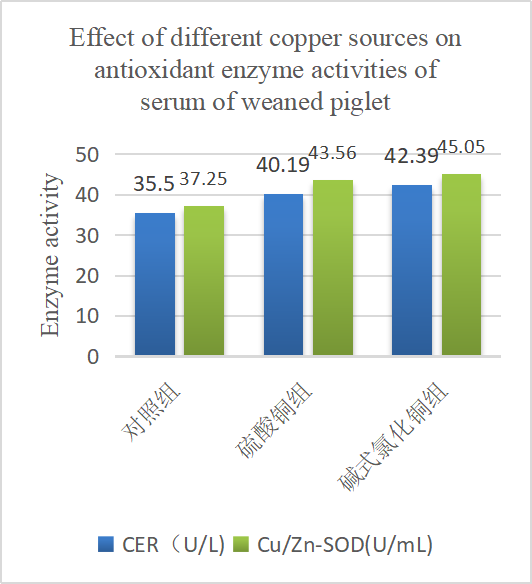
Effect of different copper sources on antioxidant enzymes of piglet
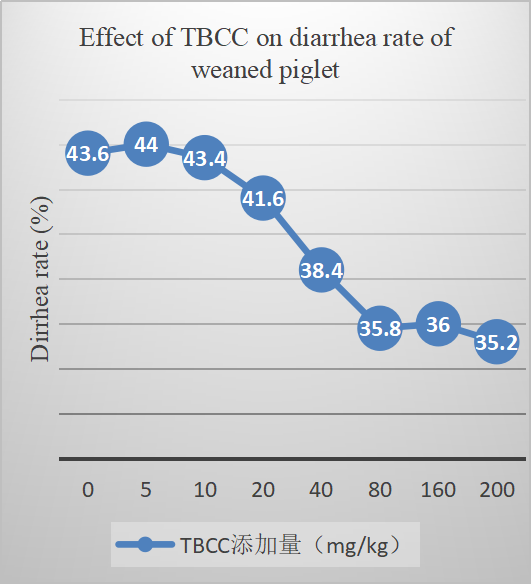
Effect of TBCC on diarrhea rate of weaned piglet
(II) Growing-finishing pig
Ensuring intestinal health of growing-finishing pig is the precondition for healthy growth of animals. The depth of intestinal crypts can represent the maturity of enterocyte. The shallower intestinal crypt is the stronger intestinal secretion function is. After growing-finishing pig is fed with tri-basic copper chloride, the depth of intestinal crypt decreases, the intestinal secretion function improves, and daily gain, feed conversion ratio and carcass weight increase.
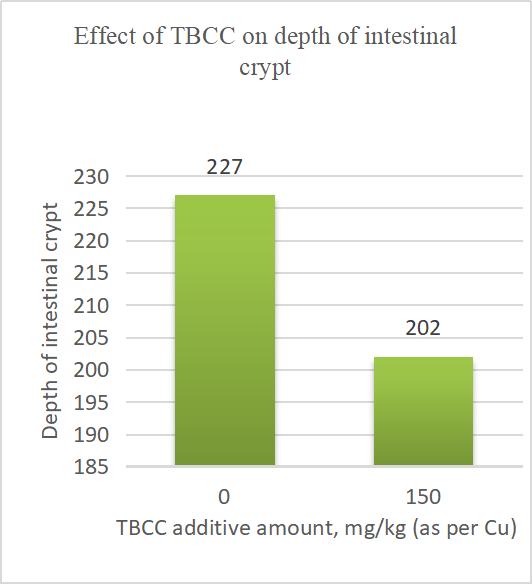
Effect of TBCC on intestinal tract of piglets
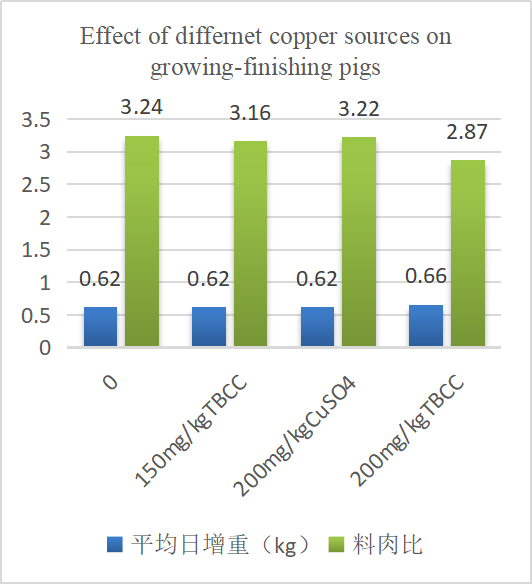
Effect of TBCC on intestinal tract of piglets
(III) Broiler duck
Research shows that adding 10mg/kg tri-basic copper chloride (as per Cu) into feed has the same effect on improving growth performance, intestinal morphology and mineral elements in tissues of broiler duck as 150mg/kg CuSO4 (as per Cu); while adding 150mg/kg tri-basic copper chloride (as per Cu) can better improve productivity and intestinal morphology of broiler duck.
(IV) Broiler chicken
Tri-basic copper chloride can stimulate secretion of hormones relating to growth and ingestion and improve immunity function and physical health of intestinal tract, in order to increase productivity of broiler chicken and feed reward and decrease the feed conversion ratio.
|
Copper source |
Copper level |
Day1-21 |
Day22-42 |
Day1-42 |
|||||||||
|
BW1d g/bird |
BW21d g/bird |
AFI g/bird |
BWG g/bird |
F:G g:g |
BW42d g/bird |
AFI g/bird |
BWG g/bird |
F:G g:g |
AFI g/bird |
BWG g/bird |
F:G g:g |
||
|
CON |
0 |
43.47 |
821.5* |
1057* |
778.0* |
1.359 |
2491* |
2897 |
1670 |
1.734 |
3954 |
2447* |
1.614 |
|
CuS |
40 |
43.5 |
847 |
1091 |
803.5 |
1.358 |
2514b |
2901 |
1667 |
1.740 |
3993 |
2471b |
1.616 |
|
80 |
43.45 |
868.4 |
1139 |
825.2 |
1.381 |
2530b |
2916 |
1662 |
1.755 |
4055 |
2487b |
1.630 |
|
|
120 |
43.47 |
872.2 |
1123 |
828.7 |
1.356 |
2533b |
2887 |
1661 |
1.738 |
4010 |
2490b |
1.611 |
|
|
160 |
43.55 |
869.7 |
1121 |
826.2 |
1.356 |
2549b |
2946 |
1679 |
1.754 |
4067 |
2505b |
1.623 |
|
|
CuT |
40 |
43.42 |
863.9 |
1101 |
820.7 |
1.341 |
2536b |
2899 |
1672 |
1.733 |
4000 |
2493b |
1.604 |
|
80 |
43.50 |
903.8 |
1168 |
860.2 |
1.357 |
2637a |
2978 |
1734 |
1.718 |
4147 |
2594a |
1.599 |
|
|
120 |
43.47 |
886.7 |
1126 |
843.2 |
1.335 |
2555b |
2869 |
1668 |
1.720 |
3995 |
2511b |
1.591 |
|
|
160 |
43.48 |
897.6 |
1167 |
854.1 |
1.366 |
2548b |
2857 |
1650 |
1.731 |
4023 |
2504b |
1.607 |
|
|
SEM |
0.04 |
12.87 |
19.83 |
12.86 |
0.012 |
12.03 |
42.14 |
19.48 |
0.020 |
40.73 |
12.02 |
0.014 |
|
Note: a-c values without the same superscript show a significant difference (P<0.05); CON: Control; CuS: CuS: Copper sulfate; CuT: Tri-basic copper chloride; AFI: Average feed intake; BWG: Body weight gain; F:G: Feed-gain ratio; * represents a significant difference in control and all copper groups (P<0.05).
(V) Ruminants
Tri-basic copper chloride is insoluble in water and releases a little Cu2+, so it does not have an antagonistic effect on Cu, S and Mo in the rumen but it can improve the bioavailability of copper and the digestibility of rumen. Moreover, it can better increase the daily gain and feed conversation ratio of ruminant and the culture benefit and reduce the feed cost than copper sulfate and cu-lys.
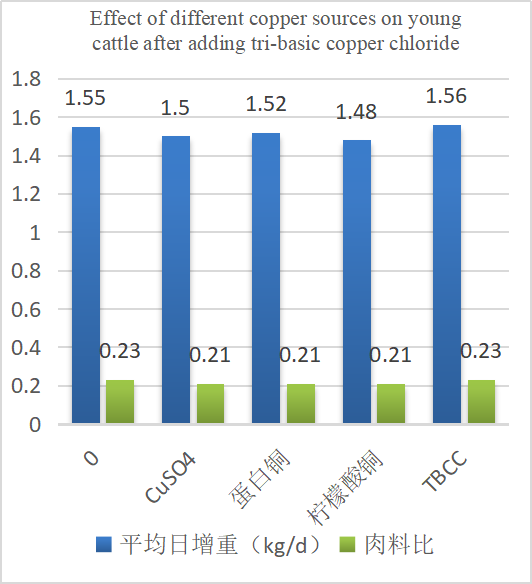
Effect of different copper sourceson young cattle
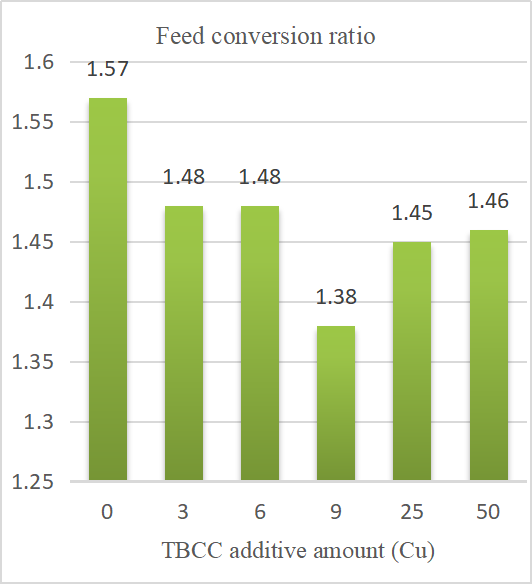
Effect of TBCC on carassius auratus gibelio
(VI) Aquatic livestock
Adding tri-basic copper chloride into aquatic feed can improve productivity, digestion rate and blood biochemical index of aquatic livestock and increase the intestinal microbial flora, so it has a certain potential value for the application of aquatic feed.
Usage and Dosage
Scope of application: Weaned piglets, growing-finishing pigs, poultry, ruminants, fishes, shrimps and crabs, etc.
Usage and dosage: Dosage of g/T mixed feed is shown below.
|
Additive amount, mg/kg (as per element) |
|||
|
Animal category |
Domestic recommended additive amount |
Upper limit |
SUSTAR recommended additive amount |
|
Pig |
3-6 |
125 (piglet) |
6.0 –15.0 |
|
Chicken |
6-10 |
8.0 – 15.0 |
|
|
Calf |
15 (pre-ruminant) |
5-10 |
|
|
30 (other calves) |
10-25 |
||
|
Sheep |
15 |
5-10 |
|
|
Goat |
35 |
10-25 |
|
|
Crustacea |
50 |
15-30 |
|
|
Other |
25 |
||
|
Note: The recommended dosage can meet the basic need for copper. If there is special need, the dosage can be adjusted. |
|||
Packing specification: 25kg/bag, duplex bag.
Storage method: Sealed and stored in a cool, well-ventilated and dry place.
Storage life: 24 months
EU standard for dioxin and PCBs
|
Item |
Upper limit |
|
Dioxin |
1ng/kg |
|
PCBs |
0.35ng/kg |
|
Sum of dioxin and dioxin PCBs |
1.5ng/kg |
|
Dioxin PCBs |
10μg/kg |
Media Contact:
Elaine Xu
SUSTAR Group
Email: elaine@sustarfeed.com
Mobile/WhatsApp: +86 18880477902
Post time: Jul-22-2025




